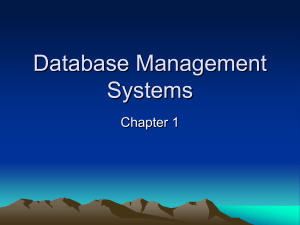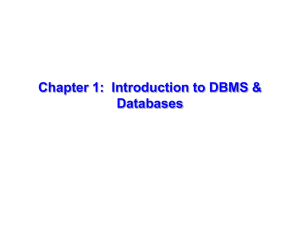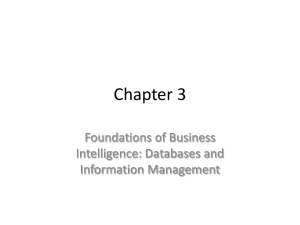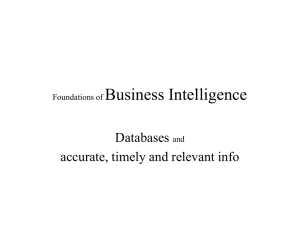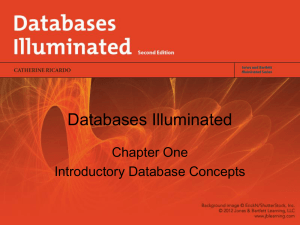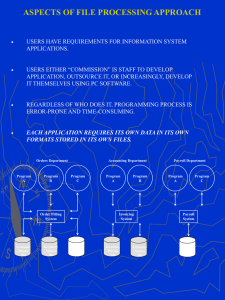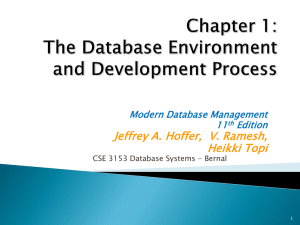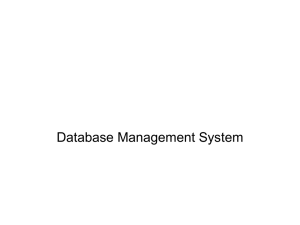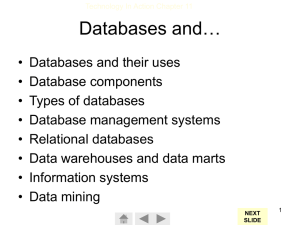Into. to Databases PPT(my lecture)
advertisement
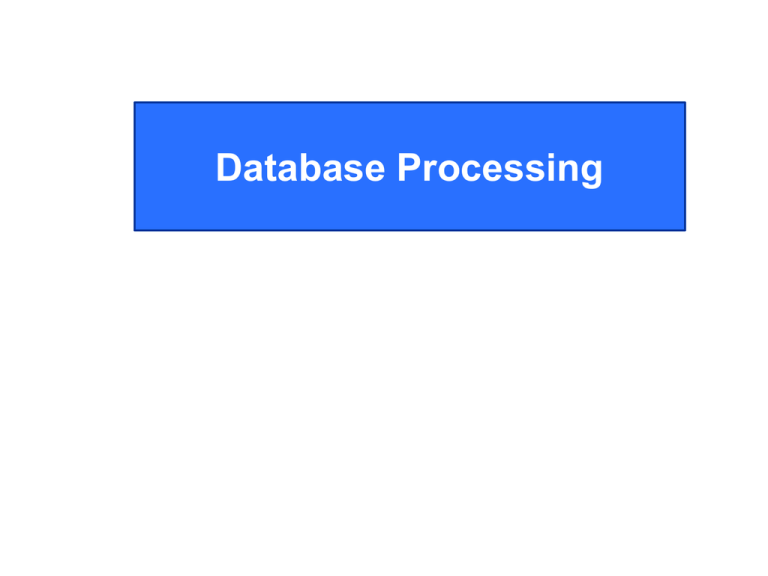
Database Processing What Is the Purpose of a Database? • Purpose: to keep track of things • If structure of a list is simple, i.e., one theme, no need to use database technology (video) General Rule • Lists of data involving a single theme can be stored in a spreadsheet. • Lists that involve data with multiple themes require a database. Database • Database: A self-describing collection of integrated records In databases, bytes are grouped into columns, such as Student Number and Student Name. Columns are also called fields. Columns or fields, in turn, are grouped into rows, which are also called records. Characters, Fields, and Records Hierarchy of Data Elements What Are Relationships Among Rows? First row of the Email Table is related to Andrea Baker in Student Table Last row in Office_Visit Table related to Adam Verberra in Student Table Relationship Special Terms • Key – Primary Key A column or group of columns that identifies a unique row in a table. Student Number is the primary key of the Student table. Given a value of Student Number, you can determine one and only one row in Student. Only one student has the number 1325. Every table must have a primary key. Sometimes more than one column is needed to form a unique identifier. In a table called City, for example, the primary key would consist of combination of columns (City, State). Email_Num is the key of Email Table. VisitID is the key of Office_Visit Table. Relationship Special Terms • Foreign keys These are primary keys of a different (foreign) table than the table in which they reside. • Relational databases Relationships among tables are created by using foreign keys. • Relation Formal name for a table Metadata • Database: A database is a self-describing collection of integrated records. • Metadata Data that describe data Components of a Database Application System • Applications make database data more accessible and useful. • Users employ a database application that consists of forms, formatted reports, queries, and application programs. • Database management system (DBMS) processes database tables for applications. What Is a Database Management System (DBMS)? • DBMS A program (software) used to create, process, and administer a database • Companies license DBMS products from vendors: IBM, Microsoft, Oracle, and others • Popular DBMS products are: DB2 from IBM Access and SQL Server from Microsoft Oracle from the Oracle Corporation MySQL—an open-source DBMS product that is license-free for most applications Creating the Database and Its Structures • Database developers use the DBMS to create and modify tables, relationships, and other structures in the database. • Below, the developer has added a new column called Response?. This new column has data type Yes/No. Processing the Database • DBMS operations Read, insert, modify, delete data Applications call DBMS in different ways • From a form, when the user enters new or changed data, a computer program behind the form calls the DBMS to make the necessary database changes. • From an application program, the program calls the DBMS directly to make the change. Structured Query Language (SQL) • SQL—“see-quell” • International standard language for creating databases and database structures, and processing databases • All five of the most popular DBMS products accept and process SQL. • Following SQL statement inserts a new row into the Student table: INSERT INTO Student ([Student Number], [Student Name], HW1, HW2, MidTerm) VALUES (1000, ’Franklin, Benjamin’, 90, 95, 100); Administering the Database • DBMS provides tools to assist in administration of the database. • Used to set up a security system involving user accounts, passwords, permissions, and limits for processing the database • Backing up database data, adding structures to improve performance of database applications, removing data no longer wanted or needed, and similar tasks • Most organizations dedicate one or more employees to the role of database administration. What Are Forms, Reports, and Queries? Reports show data in a structured context. What Are Forms, Reports, and Queries? Sample query form used to enter phrase for search Sample query results of query operation Why Are Database Application Programs Needed? • Forms, reports, and queries work well for standard functions. However, most applications have unique requirements that a simple form, report, or query cannot meet. • Application programs process logic that is specific to a given business need. • Application programs serve as an intermediary between the Web server and database. Responds to events, such as when a user presses a submit button; also reads, inserts, modifies, and deletes database data Four Database Application Programs Running on a Web Server Computer Enterprise DBMS vs. Personal DBMS • Enterprise DBMS • Process large organizational and workgroup databases Support many, possibly thousands, of users and many different database applications Support 24/7 operations and can manage databases that span dozens of different magnetic disks with hundreds of gigabytes or more of data IBM’s DB2, Microsoft’s SQL Server, and Oracle’s Oracle are examples of enterprise DBMS products. Personal DBMS Designed for smaller, simpler database applications Used for personal or small workgroup applications that involve fewer than 100 users (normally fewer than 15), single user Access: A DBMS and an Application Development Product Before building a database, developers construct a logical representation of database data called a data model to describe the data and relationships to be stored in database. What Is the Entity-Relationship Data Model? • Entity-relationship (E-R) data model A tool for constructing data models Developers use it to describe the content of a data model by defining entities that will be stored in database and relationships among those entities Entities • Some thing that the users want to track • Examples of entities: Order, Customer, Salesperson, and Item. Some entities represent a physical object, such as Item or Salesperson; others represent a logical construct or transaction, such as Order or Contract. Entity names are always singular. • Attributes Describe characteristics of an entity. Examples: order attributes are OrderNumber, OrderDate, SubTotal, Tax, Total, and so forth. • Identifier An attribute (or group of attributes) whose value is associated with one and only one entity instance. Student Data Model Entities Entities with Relationships Sample Relationship (Version 1) Crow’s Feet 1:N N:M 1:N = many-to-many relationships N:M = many-to-many relationships One department can have many advisers, but an adviser has at most one department. One adviser can have many students and one student can have many advisers. Sample Relationships (Version 2) Advisers may advise in more than one department, but a student may have only one adviser, representing a policy that students may not have multiple majors. Crow’s-Foot Diagram Version Maximum cardinality—maximum number of entities that can be involved in a relationship. Vertical bar on a line means that at least one entity of that type is required. Minimum cardinality—minimum number of entities that can be involved in a relationship. Small oval means that the entity is optional; the relationship need not have an entity of that type. Database Design • Database design is the process of converting a data model into tables, relationships, and data constraints. • Database design team transforms entities into tables and expresses relationships by defining foreign keys. • Two important database design concepts: normalization and the representation of two kinds of relationships. • Normalization is a foundation of database design. • Representation of relationships will help you understand important design considerations. Normalization Normalization is the process of converting a poorly structured table into two or more well-structured tables. Problem with these tables, have two independent themes: employees and departments. Data Integrity Problems • In previous figure, some rows show Dept. 100 is “Accounting and Finance” and others show Dept. 100 is “Accounting.” Which one is correct? • A table with data integrity problems will produce incorrect results and inconsistent information. • Data integrity problems happen when data are duplicated. • Users will lose confidence in the information, and system will develop a poor reputation. Information systems with poor reputations become serious burdens to the organizations that use them. Normalizing for Data Integrity • Normalized tables eliminate data duplication, but they can be slower to process. • General goal of normalization is to construct tables such that every table has a single topic or theme. Normalizing for Data Integrity • The way to correct the problem is to split the table into two tables, each with its own theme. Summary of Normalization • Database practitioners classify tables into various normal forms according to the kinds of problems they have. • Transforming a table into a normal form to remove duplicated data and other problems is called normalizing the table. • Normalization is just one criterion for evaluating database designs. Normalized designs can be slower to process, database designers sometimes choose to accept nonnormalized tables. The best design depends on the users’ processing requirements. Representing Relationships Representing a 1:N Relationship Representing an N:M Relationship Using Databases to Improve Business Performance and Decision Making • Very large databases and systems require special • Very large databases and systems require special capabilities, tools capabilities, tools • To analyze large quantities of data •• • To largefrom quantities ofsystems data To analyze access data multiple To access data from multiple systems •• •• Data Data warehousing mining Data Tools mining for accessing internal databases through the Web • Three key techniques • Three key techniques • Data warehousing • Tools for accessing internal databases through the Web Using Databases to Improve Business Performance and Decision Making • Data warehouse: • Stores current and historical data from many core operational transaction systems • Consolidates and standardizes information for use across enterprise, but data cannot be altered • Data warehouse system will provide query, analysis, and reporting tools • Data marts: • Subset of data warehouse • Summarized or highly focused portion of firm’s data for use by specific population of users • Typically focuses on single subject or line of business Using Databases to Improve Business Performance and Decision Making Components of a Data Warehouse The data warehouse extracts current and historical data from multiple operational systems inside the organization. These data are combined with data from external sources and reorganized into a central database designed for management reporting Figure 6-13 users with information about the and analysis. The information directory provides data available in the warehouse. Using Databases to Improve Business Performance and Decision Making • Business Intelligence: • Tools for consolidating, analyzing, and providing access to vast amounts of data to help users make better business decisions • E.g., Harrah’s Entertainment analyzes customers to develop gambling profiles and identify most profitable customers • Principle tools include: • Software for database query and reporting • Online analytical processing (OLAP) • Data mining Business Intelligence Using Databases to Improve Business Performance and Decision Making A series of analytical tools works with data stored in databases to find patterns and insights for helping managers and employees make better decisions to improve organizational Figure 6-14 performance. Using Databases to Improve Business Performance and Decision Making • Online analytical processing (OLAP) • Supports multidimensional data analysis • Viewing data using multiple dimensions • Each aspect of information (product, pricing, cost, region, time period) is different dimension • E.g., how many washers sold in East in June compared with other regions? • OLAP enables rapid, online answers to ad hoc queries Using Databases to Improve Business Performance and Decision Making The view that is showing is product versus region. If you rotate the cube 90 degrees, the face that will show is product versus actual and projected sales. If you rotate the cube 90 degrees again, you will Figure 6-15 see region versus actual and projected sales. Other views are possible. Multidimensional Data Model Using Databases to Improve Business Performance and Decision Making • Data mining: • More discovery driven than OLAP • Process by which great amounts of data are analyzed and investigated • Finds hidden patterns, relationships in large databases and infers rules to predict future behavior • E.g., Finding patterns in customer data for one-to-one marketing campaigns or to identify profitable customers. • Key areas where businesses are leveraging data mining include: • Customer segmentation • Marketing and promotion targeting • Market basket analysis • Collaborative filtering • Customer churn • Fraud detection • Financial modeling Data Mining Methods • Classification – Define data classes • Estimation – Assign a value to data • Affinity grouping or association rules – Determine which data goes together • Classification - Recognizes patterns that describe group to which item belongs • Clustering – Organize data into subgroups • Description and visualization – Get a clear picture of what is happening 47 Using Databases to Improve Business Performance and Decision Making • Predictive analysis • Uses data mining techniques, historical data, and assumptions about future conditions to predict outcomes of events • E.g., Probability a customer will respond to an offer or purchase a specific product • Text mining • Extracts key elements from large unstructured data sets (e.g., stored e-mails) Data Aggregators • Laws that limit the data that federal and other governmental agencies can acquire and store. • Some legal safeguards on data maintained by credit bureaus and medical facilities. • No such laws that limit data storage by most companies (nor are there laws that prohibit governmental agencies from buying results from companies like Acxiom. How Will this Change by 2020? • Absent any public outcry for legislation to limit such activity, aggregator data storage will continue to grow exponentially and companies will have even more data about you, the state of your health, your wealth, your purchase habits, your family, your travel, your driving record, and, well, anything you do. • Query, reporting, and data mining technology will improve and Moore’s law will make computer operations that are too slow to be practical today, feasible tomorrow. • The picture of you will become more and more detailed. Why Do You Care? • Data could be stolen and used for criminal activity against you. • Data might not be accurate • More than 25% of critical data in Fortune 1000 company databases are inaccurate or incomplete • Most data quality problems stem from faulty input. • No organization is required by law to tell you the data that it stores about you and what it does with it. Protecting Your Data • What can you do? Ask the following questions: – For what purpose is the data being gathered? – Are the reasons for gathering the data legitimate or important to you? – How will the information gathered be protected once it has been obtained? – Will the information collected be used for purposes other than those for which it was originally collected? – Could the information asked for be used for identity theft? – Are organizations that already have your data safeguarding it? 52 What If… • You enroll in a “healthy eaters” medical insurance program, similar to “safe drivers” auto insurance. Your premiums are lower because you eat well, except that the insurance company notes from last month’s data that you bought four large packages of Cheetos, and your health insurance premium is increased, automatically. You have no idea why. • Could this actually happen – or something like this?
